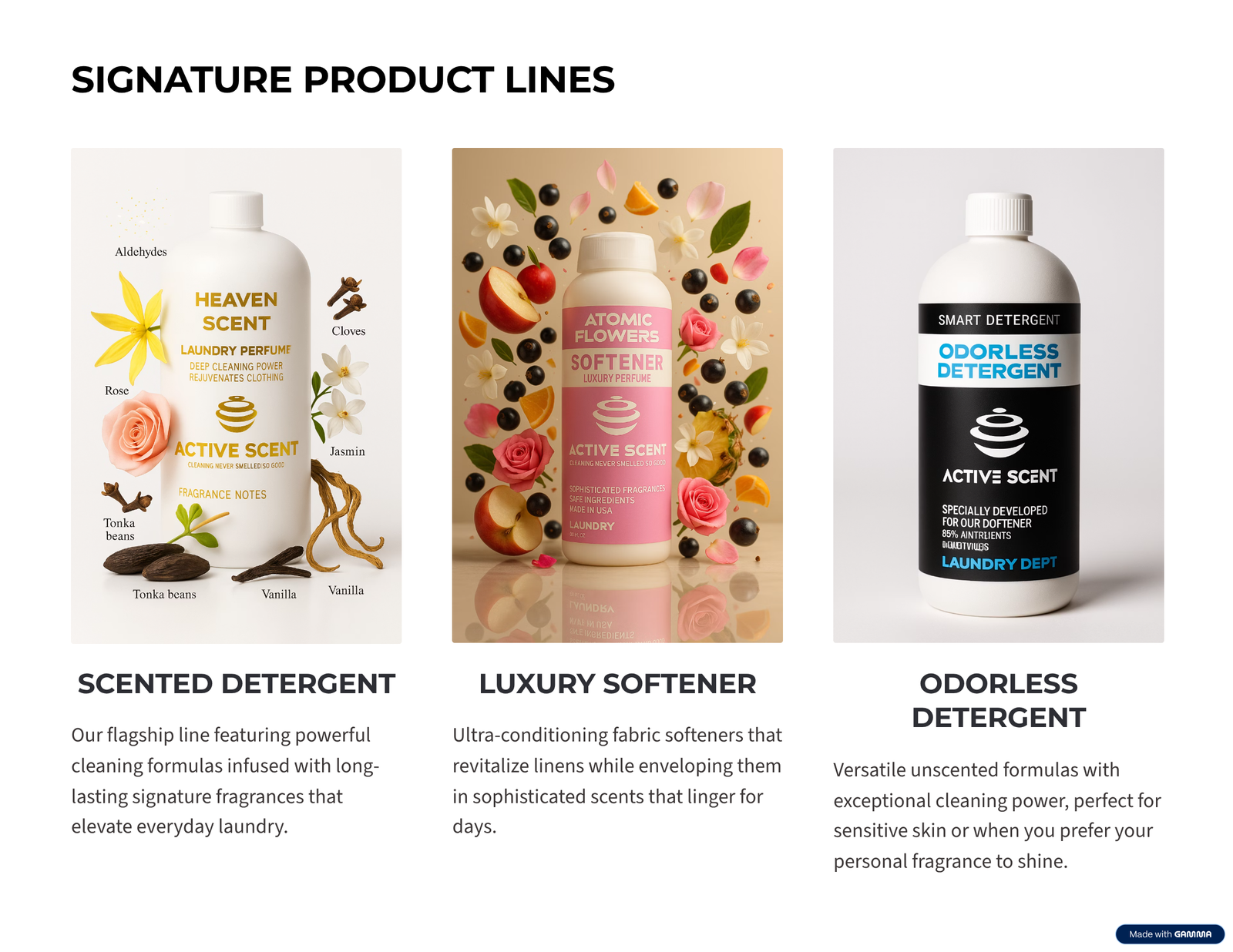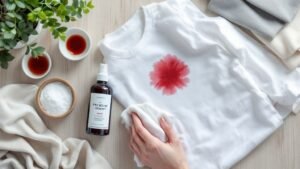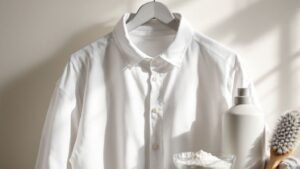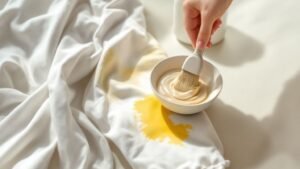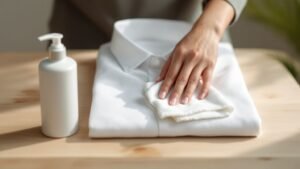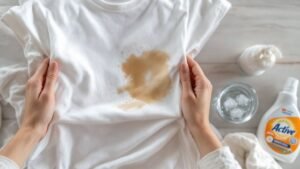
How to Remove Yellow Stains from White Clothes Easily
Before you can restore your whites to their brilliant, crisp glory, you have to know what you’re up against. Removing those frustrating yellow stains isn’t just about a better detergent; it’s about understanding the source of the discoloration and tackling it head-on.
Why Your White Clothes Are Really Turning Yellow
We’ve all been there. You reach for your favorite white t-shirt, only to find it’s taken on a dull, yellowish hue that definitely wasn’t there before. This isn't a one-off accident. That dingy color is usually the result of a slow, sneaky buildup from a few common sources.
Figuring out the why is the first, most critical step in bringing your whites back to life.
Common Culprits Behind Discoloration
One of the most frequent offenders, especially around the underarms, is a simple chemical reaction. The aluminum found in most antiperspirants mixes with the proteins in your sweat, and over time, that reaction creates those stubborn, hard-to-lift yellow stains.
But sometimes, the problem is your laundry routine itself. Using too much detergent or fabric softener seems like it would make things cleaner, but it can actually leave behind an invisible residue. This sticky film becomes a magnet for dirt and body oils, leading to that all-over dingy look. This buildup doesn't just look bad; it can also trap unpleasant odors. If you’ve ever noticed a musty smell that won’t quit, you can find more tips on how to clean mildew smell from clothes to get to the root of the problem.
The Science of Stains and Storage
Even clothes that go into storage perfectly clean aren't safe. A process called oxidation can happen over time. Invisible traces of body oils or leftover laundry products can slowly react with oxygen in the air, causing them to break down and turn yellow.
This is exactly why a perfectly crisp white shirt can emerge from a storage box months later looking discolored. The secret is making sure every last trace of body soil and product is washed away before it gets put away.
Knowing whether you’re fighting a fresh sweat stain or a case of long-term yellowing is key. A new stain needs immediate, focused treatment, while general dinginess from residue or storage calls for a broader brightening strategy. This insight helps you choose the right approach, ensuring your whites stay brilliant and their scent makes a bold, unforgettable statement. LAUNDRY NEVER SMELLED SO GOOD!
Your Pre-Treatment Playbook for Yellow Stains
The real secret to flawlessly white clothes isn't just about the final wash—it’s about the strategic first strike. Pre-treating is your chance to break down yellow stains at their source, giving your detergent a fighting chance to lift them away completely. This crucial step targets the discoloration directly, loosening its grip on the fabric fibers.
Think of it like preparing a canvas. Before creating a masterpiece, you ensure the surface is clean and primed. Similarly, before our Active Scent detergent and luxury softener can work their magic, you need to dissolve the compounds causing the yellowing. Without this step, even the most powerful wash cycle might only fade the stain, not eliminate it entirely.
Creating Your Stain-Lifting Paste
For those common yellow stains, especially from sweat and deodorant buildup, a simple but potent paste made from household staples can work wonders. One of the most effective methods I’ve found combines baking soda and hydrogen peroxide. The baking soda acts as a gentle abrasive to scrub the stain, while the peroxide provides a mild bleaching effect.
Here’s how to do it:
- Mix equal parts baking soda and a 3% hydrogen peroxide solution into a thick paste.
- Gently work it into the stained area with an old toothbrush.
- Let it sit for about 15 to 30 minutes before rinsing with cold water.
This method is so effective because it tackles the stain both physically and chemically, breaking it down for an easier wash. You can discover more powerful home laundry solutions from laundrysauce.com.
The goal of pre-treatment is simple: weaken the stain before it enters the wash. This targeted approach prevents the heat of the wash cycle from accidentally setting the stain deeper into the fabric, which can make it permanent.
Natural Stain Remover Comparison
Not all stains are created equal, and different natural ingredients offer unique benefits. Knowing which one to grab can save you time—and your favorite white shirt. Here's a quick rundown of some go-to options.
| Ingredient | Primary Action | Best For | Application Tip |
|---|---|---|---|
| Baking Soda Paste | Mild Abrasive & Deodorizer | Underarm sweat stains and general yellowing from body oils. | Mix with a little water or hydrogen peroxide and scrub gently with a soft brush. |
| Distilled White Vinegar | Acidic Stain Dissolver & Brightener | Mildew spots, residue buildup, and neutralizing odors. | Create a soak with one part vinegar to four parts hot water; let sit for an hour. |
| Lemon Juice & Salt | Natural Bleaching & Scrubbing | Food-based yellow stains and outdoor grime. | Apply juice, sprinkle with salt, and let the garment sit in the sun for an hour. |
By choosing the right pre-treatment, you set the stage for a truly deep and effective clean. This initial effort ensures that when it’s time for the main wash, your detergent can focus on overall brightness, leaving behind nothing but an exceptionally clean garment ready to be infused with a bold, mysterious, and unforgettable fragrance.
Mastering the Wash for the Brightest Whites
Now that you’ve pre-treated those stubborn yellow stains, it's time for the main event. This is where you reclaim that brilliant, like-new white. The wash cycle is more than just a rinse; it's your chance to lift away the last traces of discoloration and bring your fabrics back to life, delivering a spark of joy and a surge of confidence with every item you pull from the machine.
For durable fabrics like cotton and linen, your first ally is hot water. It's incredibly effective at breaking down the body oils and grime that cause yellowing in the first place. Always check the care label, of course, but don't be afraid to turn up the heat when you can.
The Power of a Performance Detergent
The real star of the show, though, is your detergent. Choosing an EXCEPTIONAL product is absolutely critical.
This is where Active Scent's odor-free laundry detergent truly excels. It’s been meticulously formulated for a deep and effective clean, without competing fragrances. Powerful cleaning. Zero interference. It’s the ultimate neutral base, created to perfectly complement our range of luxury scented fabric softeners.
This zero-interference approach allows the complex, luxurious notes of your chosen softener to truly shine. Inspired by the spirit of iconic French houses like Dior, Mugler, Chanel, and Le Labo, our fragrances are bold, mysterious, hypnotic, and unforgettable olfactory statements. They don't just tell a story, they leave a lasting impression.
A truly deep clean prepares the fabric for its final fragrance. By purging all impurities with a powerful, unscented detergent, you ensure the sophisticated notes of your softener—like deep, earthy patchouli fused with the burning radiance of amber—become the signature scent of your impeccably clean clothes.
Essential Rules for Washing Whites
Of course, achieving that exceptional clean takes more than just the right products. It demands the right technique. A few overlooked details can easily sabotage your efforts, leaving you with dull, grayed whites instead of brilliant ones.
To give your whites the treatment they deserve, follow these non-negotiable guidelines:
- Wash Whites Separately: It might seem obvious, but even the palest colors can transfer minuscule amounts of dye. Over time, this slowly dulls your whites. A whites-only load isn't just a suggestion; it's essential.
- Avoid Overloading the Machine: Your clothes need room to move. An overloaded washer just pushes dirt around instead of rinsing it away, leading to a frustratingly ineffective clean.
- Use the Correct Detergent Amount: More is not better here. Too much detergent leaves behind a sticky residue that actually attracts more dirt, making your clothes look dingy faster. Just follow the instructions for your load size.
Mastering these steps creates the ideal conditions for lifting away yellow stains for good. For an even deeper dive into perfecting your routine, you can learn more about how to wash white clothes in our comprehensive guide.
Advanced Tactics for Stubborn and Old Stains
Sometimes, a regular wash cycle just won't cut it. We’ve all been there—you pull a favorite white shirt from the closet only to find a deep, yellowed stain that seems to have appeared out of nowhere. It's frustrating, especially on a treasured garment.
When pre-treating and washing aren't enough, it’s time to bring out the heavy hitters. These methods go beyond the surface, using intensive soaks to break down old, oxidized stains and give your clothes one last chance to be restored to their former brilliance.
The Power of an Oxygen-Based Soak
For widespread or particularly stubborn yellowing, an extended soak with an oxygen-based bleach is my go-to rescue mission. It's a game-changer. Unlike traditional chlorine bleach that can weaken fibers and even make protein stains (like sweat) worse, oxygen bleach works its magic gently.
Here’s how to set up a restorative soak:
- Grab a basin or tub and dissolve a powdered oxygen-based bleach in warm or hot water. Just follow the directions on the package for the right ratio.
- Submerge your white clothes completely. You want every fiber to be saturated.
- Now, walk away. Let the garments soak for at least four hours, but for seriously discolored items, leaving them overnight is best.
After the long soak, just toss the items into the washing machine and run a normal cycle. You’ll be amazed at how this simple process can lift away years of set-in grime. It’s a similar trick I use when figuring out how to clean polyester and other synthetics that cling to oils and stains.
The real secret here is patience. A deep soak gives the active ingredients time to penetrate the fabric and methodically break down the chemical bonds causing the yellow stain. It’s a gentle but relentless process that lifts discoloration without damaging the garment.
The Future of Fabric Care
At Active Scent, our lead perfumer and aroma designer masterfully master light and shadow, creating scents that are as enigmatic as they are energetic and refreshing. Inspired by the luxurious complexity of raw materials, we use premium, avant-garde, and sometimes exotic ingredients to olfactorily capture the essence of contemporary individuality.
This commitment to innovation extends to the science of cleaning. Researchers are exploring eco-friendly techniques that move beyond traditional chemicals. One of the most promising is a photobleaching method that uses high-intensity blue LED light and ambient oxygen to lift stains. This process avoids harsh oxidants completely, making it a potentially perfect solution for delicate fabrics. You can dive into the details of this groundbreaking stain removal research to see what's next in laundry care.
How To Keep Your White Clothes From Yellowing
Getting your whites back to brilliant is one thing, but keeping them that way is the real art. The secret isn't some complicated laundry ritual—it's about adopting a few smart, simple habits that stop yellowing before it even thinks about starting.
One of the easiest tweaks you can make is just letting your deodorant or antiperspirant dry completely before you pull on a white shirt. That little pause is a game-changer. It prevents the aluminum compounds from immediately transferring to the fabric, which is one of the biggest culprits behind those stubborn, yellow underarm stains.
Smart Storage and Drying Habits
How you dry and store your whites is just as crucial as how you wash them. I always try to let my white garments air-dry in the sun whenever possible. The sun's UV rays are a natural bleaching agent, helping to brighten the fabric while also taking care of any lingering odor-causing bacteria.
Once they're dry, where you put them matters more than you might think.
- Ditch the Plastic: Never, ever store your whites in plastic bags or bins. Plastic traps moisture and cuts off airflow, which creates the perfect environment for the oxidation that causes yellowing.
- Opt for Breathable Storage: Instead, use cotton garment bags or simply store them in a cool, dark closet where the air can circulate freely.
- Keep Your Machine Clean: A grimy washing machine can redeposit old residues right back onto your clean clothes. Make sure yours is in top shape with our guide on how to remove odors from your washing machine.
Here's the most important rule I've learned for preventing yellowing: wash your whites after every single wear, even if they look perfectly clean. Invisible body oils and sweat are the primary fuel for oxidation, and washing them away immediately stops the yellowing process cold.
Answering Your Toughest Yellow Stain Questions
Even the most experienced laundry aficionados run into questions now and then. Getting the details right is what separates a good result from an exceptional one, keeping those whites pristine.
Should I Use Chlorine Bleach on Sweat Stains?
It's a common impulse, but one you should absolutely resist. Always avoid chlorine bleach when dealing with protein-based stains like sweat.
Bleach triggers a chemical reaction with the proteins in sweat, which can actually set the yellow stain permanently and even make it darker. Over time, it also weakens the fabric fibers. A much safer and more effective alternative is an oxygen-based bleach.
Why Did My White Clothes Turn Yellow in Storage?
Pulling a favorite white shirt out of storage only to find it yellowed is incredibly frustrating. This is usually caused by oxidation.
Even after a wash, minuscule, invisible residues of body oils or leftover laundry products can cling to the fabric. As these residues are exposed to air over months, they slowly break down and turn yellow. The best way to prevent this is to wash your whites thoroughly before storing them. Make sure they are 100% dry and keep them in a cool, dark place with good air circulation—never sealed in plastic bins or bags.
How Do I Stop Yellow Armpit Stains From Forming?
The best defense is a good offense. Prevention starts with your daily routine, long before you even see a stain.
The main culprit is often a chemical reaction between the aluminum found in most antiperspirants and your sweat. The easiest fix? Switch to an aluminum-free deodorant. Also, give your deodorant a few minutes to dry completely before you put on your shirt. This simple step dramatically reduces how much product transfers onto the fabric, stopping those stubborn stains before they even begin.
With Active-Scent.com, discover POWERFUL DETERGENTS FUSED WITH LUXURIOUS FRAGRANCES. Our fragrances, composed of natural and ethically sourced ingredients, offer a refined and distinguished sensory experience—a bold tribute to the spirit of renowned fragrance houses.
Explore the collection and transform your laundry experience at active-scent.com.

